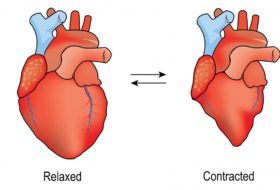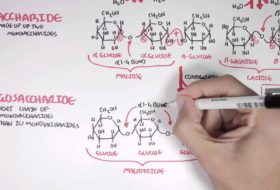Supporting Tissues
The gingiva surrounds the teeth at the base of their crown. The alveolar ridges are trabecular bone containing sockets for the teeth. The periodontium consists of the tissues that support the teeth—the gingiva, epithelial attachment, connective tissue attachment, periodontal ligament, and alveolar bone. The mandible and maxilla support the alveolar ridges and house the teeth. Saliva from the salivary glands bathes and protects the teeth. The tongue directs food between the grinding surfaces and helps clean the teeth. The maxilla receives innervation from the maxillary nerve, the 2nd division of the trigeminal nerve (the 5th cranial nerve). The mandibular nerve, which is the 3rd and most inferior division of the trigeminal nerve, innervates the mandible.
In the elderly, or in some periodontal diseases, gingival recession exposes the dental root adjacent to the crown, making root caries common. If tooth destruction results and the tooth must be removed, the mechanical stimulation necessary for maintaining bone integrity ceases. Consequently, atrophy of the alveolar ridge (senile atrophy) begins when teeth are absent.
Mouth
Normally, keratinized epithelium occurs on the facial aspect of the lips, dorsum of the tongue, hard palate, and gingiva around the teeth. When healthy, the keratinized gingiva extends 5 to 7 mm from the crown of the tooth. Nonkeratinized mucosa occurs over alveolar bone further from the teeth, inside the lips and cheeks, on the sides and undersurface of the tongue, on the soft palate, and covering the floor of the mouth. The skin and mucosa of the lips are demarcated by the vermilion border.
The buccal mucosa, including the vestibule and nonkeratinized alveolar mucosa, is usually smooth, moist, and more red than pink (as compared to healthy gingiva). Innocuous entities in this region include linea alba (a thin white line, typically bilateral, on the level of the occlusal plane, where the cheek is bitten), Fordyce granules (aberrant sebaceous glands appearing as < 1 mm light yellow spots that also may occur on the lips), and white sponge nevus (bilateral thick white folds over most of the buccal mucosa). Occasionally, pigmentation of the mucosa may arise from foreign material that is incorporated into the tissue. Most commonly, this occurs as a blue or black area adjacent to a dental amalgam filling. This is known as an amalgam tattoo. The orifices of the parotid (Stensen) ducts are opposite the maxillary 1st molar on the inside of each cheek and should not be mistaken for an abnormality. Recognizing these avoids needless biopsy and apprehension.
The dorsal surface of the tongue is covered with numerous whitish elevations called the filiform papillae. Interspersed among them are isolated reddish prominences called the fungiform papillae, occurring mostly on the anterior part of the tongue. The circumvallate papillae, numbering 8 to 12, are considerably larger and lie posteriorly in a V pattern. The circumvallate papillae do not project from the tongue but instead are surrounded by a trench. The foliate papillae appear as a series of parallel, slitlike folds on the lateral borders of the tongue, near the anterior pillars of the fauces. They vary in length and can easily be confused with malignant lesions, as may the foramen cecum, median rhomboid glossitis, and, rarely, a lingual thyroid nodule. Lingual tonsils are components of the Waldeyer ring, are at the back of the tongue, and should not be mistaken for lesions. If an apparent abnormality is bilateral, it is almost always a normal variant.
Innervation is supplied by the lingual nerves (branches of the 5th cranial nerves), for general sensory innervation, and the chorda tympani fibers (of the 7th cranial nerves), which innervate the taste buds of the anterior two thirds of the tongue. Behind the circumvallate papillae, the glossopharyngeal nerves (9th cranial nerves) provide the sensations of touch and taste. The tongue has taste receptors for sweet, salty, sour, bitter, and umami (a savory taste triggered by natural glutamic acid and glutamates such as the flavoring agent monosodium glutamate). Although previously thought to be isolated to particular portions of the tongue, taste receptors are now known to be distributed over the surface of the tongue. The hypoglossal nerves (12th cranial nerves) control movement of the tongue.
The major salivary glands are the paired parotid, submandibular, and sublingual glands. Most oral mucosal surfaces contain many minor mucus-secreting salivary glands. Anteriorly and near the midline on each side of the floor of the mouth are the openings of the Wharton ducts, which drain the ipsilateral submandibular and sublingual glands. The parotid glands drain into the cheeks via the Stensen ducts.




